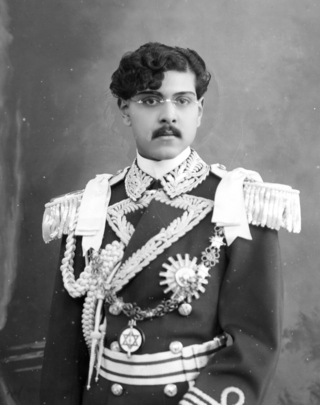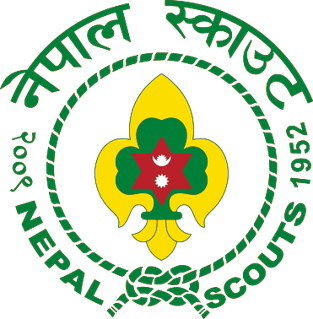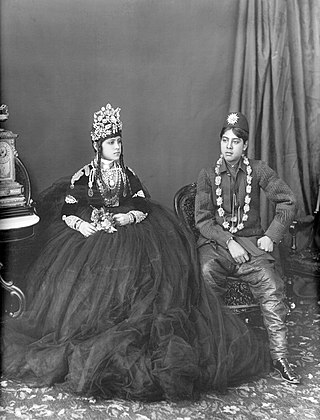
Tribhuvan Bir Bikram Shah, was the eighth King of Nepal. Born in Kathmandu, the capital city of Nepal, he ascended to the throne at the age of five, upon the death of his father, Prithvi Bir Bikram Shah, and was crowned on 20 February 1913 at the Nasal Chowk, Hanuman Dhoka Palace in Kathmandu, with his mother acting as regent. At the time of his crowning, the position of monarch was largely ceremonial, with the real governing power residing with the Rana family.

Prithvi Bir Bikram Shah, was the seventh King of Nepal. Among the most notable events of his reign were the introduction of the first automobiles to Nepal, and the creation of strict water and sanitation systems for much of the country. King Prithvi's eldest child was Princess Lakshmi, who was married to Field Marshal Kaiser Shamsher Jang Bahadur Rana. She was made the Crown Princess and was heir to Nepal's throne until she was 11, when her brother Tribhuvan was born. Until then King Prithvi only had four daughters and four from another wife.
National Heroes of Nepal is a list of 18 Nepali people, that also includes those from ancient and medieval times, who were selected to their ranks posthumously by a commission headed by famous writer Balkrishna Sama who was appointed by King Mahendra, in 1955. The commission was directed to make nominations on the basis of their contributions to the nation, its influence and consequences. On these regards, the commission nominated people by their contributions to the pride of the nation be it in religious, cultural or economic reforms, wartime bravery, to the cause of democracy, literature, architecture.

The Shah dynasty, also known as the Shahs of Gorkha or the Royal House of Gorkha, was the ruling Chaubise Thakuri dynasty and the founder of the Gorkha Kingdom from 1559 to 1768 and later the unified Kingdom of Nepal from 1768 to 28 May 2008.

The "Nepal Scouts" is the national Scouting and Guiding organization of Nepal, founded in Nepal in 1952. It became a member of the World Organization of the Scout Movement in 1969 and later became a member of the World Association of Girl Guides and Girl Scouts in 1984.

The Narayanhiti Palace Museum is a public museum in Kathmandu, Nepal located east of the Kaiser Mahal and next to Thamel. The museum was created in 2008 from the complex of the former Narayanhiti Palace following the 2006 revolution. Before the revolution, the palace was the residence and principal workplace of the monarch of the Kingdom of Nepal, and hosted occasions of state.
Prince Dhirendra Bir Bikram Shah Dev of Nepal was the youngest son of King Mahendra of Nepal and his first wife, Crown Princess Indra.
Ratna Rajya Laxmi Campus, commonly known as RR Campus, is a constituent college of Tribhuvan University (TU). It is also the largest college for the Humanities and Social sciences studies. It provides under-graduate and master's degree level programs. The college was named after Queen Ratna Rajya Lakshmi Devi Shah, second wife of the then King Mahendra Bir Bikram Shah Dev.

The Most Refulgent Order of the Star of Nepal is an award of Nepal.

The Most Illustrious Order of Tri Shakti Patta is an order of knighthood of the former Kingdom of Nepal. It is conferred on members of the royal family or Nepali citizens who make outstanding contributions to the nation, and to foreigners making special contributions to the welfare of Nepal.

The Most Puissant Order of the Gorkha Dakshina Bahu was an order of knighthood of Nepal. It was one of the highest honors given traditionally by the king. It was awarded to both the military and civilians, including foreign nationals, for distinguished contribution to the country in the field of arts, literature, sports, science, and social service. It was the second highest honor of the Kingdom of Nepal after the Order of Tri Shakti Patta; the award was discontinued after the fall of monarchy in 2008.
The Birendra Museum is a museum located in Kathmandu Durbar Square, Kathmandu, Nepal. It is located alongside Tribhuvan Museum and Mahendra Museum. It contains personal artefacts that belonged to King Birendra Bir Bikram Shah, who is internationally known Nepalese king in the modern history.

The revolution of 1951 in Nepal, also referred to as Sat Salko Kranti, was a political movement against the direct rule by the Rana dynasty of Nepal which had lasted for 104 years. It marks the beginning of the political awakening and democratic movements in Nepal, and resulted in immediate abolition of the institutionalized hereditary Prime Minister system in Nepal.
Kanti Rajya Lakshmi Devi Shah was the queen consort and first wife of Tribhuvan Bir Bikram Shah, King of Nepal. She was the mother of King Mahendra Bir Bikram Shah.

Prince Himalaya Pratap Bir Bikram Shah, GBE, GCMG was a son of Tribhuvan of Nepal and his first wife Kanti. He was a younger brother of Mahendra, and an uncle of Birendra and Gyanendra.

Prince Basundhara Bir Bikram Shah of Nepal, GCMG was a son of King Tribhuvan of Nepal.

Divyeshwari was the Queen Consort of Nepal from her marriage in 1886 to her husband's death in 1911. She was the second wife of King Prithvi of Nepal. Queen Divyeshwari was the mother of King Tribhuvan of Nepal.
Bishal Nath Upreti is a geologist and academic at the Department of Geology, Tri-Chandra Campus, Tribhuvan University, Kirtipur, Kathmandu, Nepal.
Ishwari Rajya Lakshmi Devi Shah was the queen consort and the second wife of Tribhuvan Bir Bikram Shah, King of the Kingdom of Nepal. She was the mother of Prince Basundhara Bir Bikram Shah and Princess Nalini Rajya Lakshmi Devi.

Surya Bikram Gyawali was a Nepali historian. He wrote biographies for numerous people including King Prithvi Narayan Shah and writer Bhanubhakta Acharya. Gyawali also served as a head teacher in Darjeeling. He is also a recipient of the Order of Gorkha Dakshina Bahu, the Order of Tri Shakti Patta, and the Tribhuvan Puraskar (1971).












